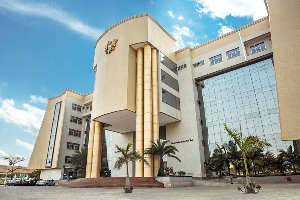Many of us must have read or heard about a novel called The Gods Are Not To Blame. It was a classical 1968 play and a 1971 novel by Ola Rotimi, a Nigerian Novelist. An adaptation of the Greek classic Oedipus Rex, the story centers on Odewale -- meaning the Hunter has come home -- who is lured into a false sense of security, only to somehow get caught up in a somewhat contagious trail of events.
The Gods Are Not To Blame does not necessarily mean the divinities of the Yoruba tradition; rather it alludes to national, political powers -- those that dictate the pace and complexion of the world’s politics. The title, he says, implies that those political 'figures' should not be blamed or held responsible for our own failings.
For instance, the very distinction between the oppressing powers on the outside and the local population on the inside is, and was, just as untenable as the difference amongst the communities that the oppressors sought to exploit.
The title of that great novel captures the events in today’s Ghanaian banking system succinctly.
Traditionally, banks are agents of economic growth and development. They perform two main Primary Functions: (i) Accepting deposits and advancing loans And the Secondary Functions are: (i) Agency functions, General functions and Developmental functions
Banks’ developmental functions
I will dwell a little more on their developmental role, because that is our interest in this article. Banks play a very significant role in the economic development of a country. Banks are like departmental stores for financial activities. The financial resources with the banks, if used effectively and efficiently, can spur economic growth and strengthen financial systems of the country through their intermediation role.
The desired Industrial development can only be achieved if entrepreneurs are provided with the needed funds to engage in profitable and productive ventures. The availability of funds can be made possible through banks. The banks help government to allocate resources to competing sectors of the economy in line with government’s economic policies and the banks’ profitability focus.
Sectors like agriculture, service industry, mining, transportation and communication benefit in no small measure from the financial support rendered by banks. Usually, they act as engines of growth and lubricate the oil of economic activities. In this way, all sectors of the economy develop -- leading to a balanced growth in the economy.
When banks create credit, it has an effect on domestic prices, incomes, employment and capital accumulation. When banks perform their real functions in the economy, the money market becomes very active and the larger economy feels the direct impact of a robust financial system.
Additionally, as financial intermediaries, banks allocate funds between surplus units and borrowers. Banks also provide pricing information regarding the cost of borrowing money. For example, information such as prevailing mortgage rates on loans of various terms helps home buyers shop for the best rates. Likewise, businesses can shop for best rates on commercial loans too.
This particular role is still under-achieved in our country, Ghana. Recently, the Bank of Ghana came up with a new policy directive to all banks: that they should publish their base rate in the papers for their customers and the public at large to know what their ‘best’ rate is.
If you have been following developments in the sector, you will notice that there is selective credit granting; some banks even have a blanket-ban on loan disbursement while others ask their customer to provide full cash back cover for the proposed facility before the bank can consider the credit request of the customer.
Surely, no economy can grow with this unconventional approach to banking business. Beyond the issue of credit granting and economic growth is the fundamental issue of lending rate: even when they decide to grant the credit, you may have to pay interest through the nose.
Why this is so disheartening is that with a multiplicity of banks in the country, we still struggle to know what role they are playing in supporting development of the economy. Should this be the case of our 21st century banking in Ghana?
If you take a census of banks in the country, we have about 27 Commercial banks, uncountable rural banks, innumerable microfinance houses, limitless savings and loans companies and a sizeable number of money-lenders -- not to mention Mortgage Financial Institutions. Despite the multiplicity of these institutions, which cannot be less than 500 companies put together in a country of less than 25 million people, we are still battling with the question: which way forward?
Recently, the Ministers in charge of Allied and Finance Institutions at the Presidency, Mr. Fiifi Kwettey, stirred up a hornet's nest in respect to who should be blamed for the high lending rate in the country.
The Honorable Minister, a brilliant and articulate young politician, recently took a swipe at the banks for charging excessive rates to enable them make super-normal profits given the least opportunity.
He said: “The issue of high lending rates to customers must be a major concern to many people, and until it addresses the economy it will not make any headway but keep going round in circles”.
Without holding any brief for the banks, I think the issue of lending rates has so many dimensions/options to get it reduced to a manageable level. The principal actors -- Government through the regulator Bank of Ghana, depositors and the banks -- must engage in a workable solution to this long-time contentious issue of high lending rates in Ghana.
Treasury bill connection
Mr. Kwetey representing government as Minister in Charge of Financial and Allied Institutions must ensure that the Treasury bill rate -- which is the minimum expected return any rational investor expects on his investment -- should be controlled or substantially brought down from its current 22 or 23% to a little above 12% as a starting point. If there is any meaningful impact to be achieved in a lending rate reduction campaign. If the Treasury bill rates remains as we have it now, it is very difficult to expect any reasonable investor of excess funds to place them with banks below what a risk-free rate return guarantees.
While we agree that banks must assist government to achieve its micro- and macro-economic objectives, it behoves government to manage its expenditure more prudently and reduce its over-dependence on Treasury bills in meeting its funding gaps.
Treasury bills should be the last resort for government in funding its operations, but it looks like in Ghana the reverse is the case.
Treasury bills rank next to taxes and levies in order of importance to our government in the pecking order of internally generated revenue, besides the cocoa fund and royalties from extractive industries. There is need for fiscal discipline and strong controls on areas of leakage in the system if we are serious about getting out of this rat-race of uncontrollable lending rate business we have today.
Financial ‘galamsey’
Secondly, it is very difficult for government to check this excessive interest rates -- the reason being that the income derived by government from the “super-normal profit” of these banks looks too juicy and irresistible for government to contemplate any clamp-down or forcing the interest rate down. The higher the taxable income of banks, the higher the taxes that enter the government coffers.
Who suffers the brunt? It is the public most certainly, because the borrower without any recourse passes on the cost to its final consumer -- who has no choice but to pay and then pray for a miracle of financial deliverance from any of the gods, depending which he believes in.
Banks, too, must key into the administration’s vision to achieve a lasting solution. I think the people in Government should find out the reason we have so many banks in the system; just as we have many more radio stations than most countries in Africa with even higher population figures than us.
The truth is that the profit margin here is extraordinarily too high. If you look at non-bank financial institutions, for instance, their average interest rate ranges from 4% to 8% per month or 48% to 96% per annum. Where in the world can you get that kind of return on investments? They pay about 30% to 36% per annum to their depositors, leaving them with a margin of about 60% per annum.
The depositors are happy at getting 36% return on their perceived risky investment (placement), banks are also happy they are making above 50% return on each transaction.
That is why you see a lot of people scrambling for Micro Finance or Savings and Loans licence: because it is the surest way to quick prosperity after the demise of Sakawa business and Galamsey clampdown.
Government is also happy that all their banks are making super-profits and paying handsome taxes. This is like ‘blood-money’ kind of business being forced out of helpless Ghanaians and foreigners alike by all the players in the system. We call our economy a democratic socialist one, but it’s at an advanced stage of pure capitalism.
Base rate/lending rate calculation
Recently, the Bank of Ghana came up with a new policy directing all banks in the country to publish their base rates in newspapers on a monthly basis for the general public to know what rate they should expect when they want to apply for loan. This brought about the issue of base rate or ‘best’ rate.
Has this changed anything? No. The idea is brilliant, but there is still more to be done by the regulatory authority to achieve a competitive interest rate regime in the country. From the template sent to banks by BoG on how to calculate the base rate, there is little or nothing any bank can do to change the basis of computation.
The only variable within the control of the banks is their projected profits, which must have been approved by their board even before the beginning of the year.
1. Cash reserve requirement -- Fixed by BOG 2. Capital adequacy rate -- Fixed by BOG 3. Corporate tax -- Fixed by GRA 4. Operating expenses -- Actual position of the bank as at the date 5. Total assets -- Actual position of the bank as at the date 6. Others assets -- Actual position of the bank as at the date 7. General provisions -- Fixed by BOG 8. Existing 91 day T/bill rate --Fixed by BOG. 9. The expected return on Equity in the bank’s budget -- As approved by the banks
How do you blame the banks for the high Interest Rate when 5 out of 9 bases of calculation are externally determined? Three out of the remaining four which are within banks’ control are actual positions of things based on the financial report rendered to BoG on a monthly basis.
Partial regulation
To help the economy, the Bank of Ghana should fix the margin on loans -- which must be uniform for all banks -- after it has reduced the Treasury-bill rate to a reasonable level, not above 12%.
Secondly, there is a need for interest rate-pegging for deposit-sourcing by banks. This automatically discourages rent-seeking investors who prefer to sit and place money with savings and loans and microfinance outfits or commercial banks at ridiculous rates. Sometimes, these rates range between 28% and 36% per annum. This is the deal-breaker. It would discourage lazy investors and force people to engage in productive investment, rather than expecting banks to trade with their money and pay them handsome interest.
If the BoG pegs deposit rates at 2% above Treasury bill rates and enforces it across the board so that no bank can take deposits above this ceiling, you will see the base rates come tumbling down. There would be an increase in economic activities from the rent-seekers who then use their brains and energy to think of what they can produce that would return more than what the banks are proposing; and banks would be ready and willing to lend to people who have genuine business proposals for them to make reasonable profit and meet their shareholders’ expectations.
The way out
To come out of this logjam, the recovery step should start with government looking at alternatives to generate income, rather than depending solely on Treasury bills or Open Market Operations -- which were supposed to be a regulatory tool of BoG to control the economy but have now become the “cheapest” revenue source to the government.
Government attention must shift from Treasury bills to other income-generating ventures as I suggested in one of my previous articles, titled “Much ado about Euro-dollar Bondage”.
If Government can reduce their penchant for raising funds through money markets on a weekly basis as is done currently, and make it quarterly at a much-reduced volume, the Treasury-bill interest rate will go down. The kind of competition we currently see between the public and private sectors for available money in the money market would ease the lending rate substantially. If we succeed in getting it below 14%, you will see that most banks’ cost of funds/base rate dramatically drops to less than 17%.
Genuine investor should be able to approach banks to borrow money below 20% interest rate for productive investment. Default rates would reduce because the interest rate is within tolerable levels for businesses to succeed and pay back the loan contracted.
Finally, economic growth we are all yearning for would become reality and unemployment issues could be solved at the national level.
The era of super-normal profit would disappear from banks. There would be elimination of lazy bankers who are only interested in lending to government through Treasury bills, since the return on Treasury bills is far above their customer’s required return if they should do the right thing.
Government-expected taxes and levies would increase significantly because of more investments being birthed daily as a result of accessibility to funding from banks at a reasonable interest rate.
Finally, most ailing or dead companies would naturally come back to life and breathe a sigh of relief as the result of a fresh injection of capital ‘blood’ into operations made available by banks.
Business News of Monday, 16 September 2013
Source: B&FT













